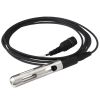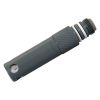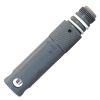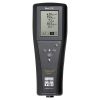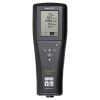YSI Pro10 pH Meter
The YSI Pro10 is a field-rugged handheld meter that measures temperature along with either pH or ORP (Oxidation Reduction Potential).
Features
- User-replaceable cables and sensors provide versatility
- Smart calibration routine allows easy calibrations with the press of a button
- Graphic backlit display with 50 dataset storage
- Free ground shipping
- Expedited repair and warranty service
- Lifetime technical support
- More
Overview
The YSI Pro10 pH meter is a field-rugged handheld meter that measures temperature and either pH or ORP (Oxidation Reduction Potential). User-replaceable sensors and cables (sold separately) and convenient calibration routine features make it user-friendly. Durable casing and 1-meter drop tests ensure years of sampling even in the harshest field conditions.
Additional Features
- Replacement cables available with 1- 4- 10- 20- and 30-m cable lengths standard (cable management kit included on all cables 4-m and longer).
- Usable in any lighting condition. The display is also visible when wearing polarized sunglasses.
- Tough, IP67, impact-resistant, waterproof case. Waterproof without the battery cover as well.
- Rubber over-molded case provides extra durability. Military spec connectors are unsurpassed for ruggedness.
- Multiple languages. Includes: English, Spanish, French, and Portuguese.
- 3-year instrument; 2-year cable; 1-year sensor warranty
- Cable Lengths: 1- 4- 10- 20- and 30-m lengths (3.28, 13.1, 32.8, 65.6, and 98.4 ft.)
- Certifications: RoHS, CE, WEEE, IP67, 1-meter drop test
- Connector: MS (military spec) waterproof with bayonet lock
- Data Memory: 50 data sets
- Dimensions: 8.3 cm width x 21.6 cm length x 5.6 cm depth (3.25 in x 8.5 in x 2.21 in)
- Languages: English, Spanish, Portuguese, French
- Power: 2 alkaline C-cells providing approximately 425 hours of battery life depending without backlight usage; low battery indicator with approximately 1 hour left
- Warranty: 3-year instrument; 2-year cable; 1-year pH and ORP sensors
- Waterproof: IP67 (even with the battery cover off)
- Weight with Batteries: 475 grams (1.05 lbs)
- (1) YSI Pro10 display
- (1) Operations manual
- (2) C-cell batteries
In The News
Three Decades of Research at Acton Lake
A multi-disciplinary team at Miami University, Ohio, has been studying the environmental change at Acton Lake for over three decades. Using three different NexSens buoys over this time, the team has an incredible archive of data that is helping build a picture of Acton’s past, present, and future. Until recently, a NexSens CB-50 buoy was used alongside other environmental monitoring at Acton Lake. In May 2025, the Miami team deployed a new XB-200 buoy , future-proofing their ongoing monitoring using real-time buoy systems. Acton Lake, a small hypereutrophic reservoir in southwest Ohio, covers 2.4km² and has a maximum depth of about 8m. The dam was built in 1956, and the lake has a large agricultural watershed.
Read MoreSource Water Monitoring in Albany, New York: Tracing Water Quality throughout Tributaries
Thousands of US cities pull their drinking water from natural source waters like reservoirs, rivers, and streams, making overall watershed health a key consideration for water providers. In Albany, New York, the Albany Department of Water and Water Supply delivers drinking water to over 100,000 residents as well as monitors and manages the larger drinking water supply watershed. Hannah Doherty, Environmental Specialist at the Albany Department of Water and Water Supply , spends her days working with a small team to monitor the drinking supply and the connected water bodies. Doherty explains, “We’re the first to encounter the water that ends up being the drinking water.
Read MoreWildfire Prevention in the Sierra Nevada Region with the Yuba Watershed Institute
Though recent wildfires have sparked new conversations about wildfire management and response, groups like the Yuba Watershed Institute have been monitoring the forests and water resources of the Sierra Nevada region for decades, managing approximately 5,000 acres of land with the Bureau of Land Management (BLM) and about 7,000 acres in private land partnerships. The goal of the Institute is to work with local communities and land agencies to improve watershed and forestry management through informed practices and public outreach. The goals of the Yuba Watershed Institute are three-fold: Improve the ability of fire suppression agencies like the California Department of Forestry and Fire Protection ( CAL FIRE ) and the US Forest Service.
Read More

























